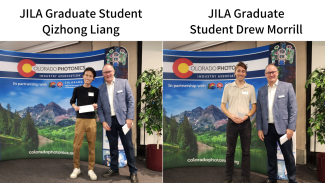Every year, the Colorado Photonics Industry Association (CPIA) holds a university meeting where students from several of Colorado's prominent universities present their work as a poster to an industry audience, followed by networking with potential employers. For students, it's an excellent opportunity to practice public speaking, share their current research projects, and find potential industry jobs. Each year, three students are awarded a cash prize for how well they communicate their research and the design of their poster.
This year, JILA graduate students Qizhong Liang, from JILA and NIST Fellow Jun Ye's research group, and Drew Morrill, from JILA Fellows Margaret Murnane's and Henry Kapteyn's research group, have been awarded prizes for their poster presentations. Both researchers designed an engaging poster that complimented their talk. Morrill's poster, titled: "High-harmonic generation from a 3 μm wavelength OPCPA," discussed a method to generate soft X-rays using laser arrays. Liang's, in contrast, focused on using frequency combs for molecular detection, as his poster was titled: "Detect COVID-19 with a frequency comb laser breathalyzer." Congratulations to both Qizhong and Drew for their outstanding work!



 The Physics Frontiers Centers (PFC) program supports university-based centers and institutes where the collective efforts of a larger group of individuals can enable transformational advances in the most promising research areas. The program is designed to foster major breakthroughs at the intellectual frontiers of physics by providing needed resources such as combinations of talents, skills, disciplines, and/or specialized infrastructure, not usually available to individual investigators or small groups, in an environment in which the collective efforts of the larger group can be shown to be seminal to promoting significant progress in the science and the education of students. PFCs also include creative, substantive activities aimed at enhancing education, broadening participation of traditionally underrepresented groups, and outreach to the scientific community and general public.
The Physics Frontiers Centers (PFC) program supports university-based centers and institutes where the collective efforts of a larger group of individuals can enable transformational advances in the most promising research areas. The program is designed to foster major breakthroughs at the intellectual frontiers of physics by providing needed resources such as combinations of talents, skills, disciplines, and/or specialized infrastructure, not usually available to individual investigators or small groups, in an environment in which the collective efforts of the larger group can be shown to be seminal to promoting significant progress in the science and the education of students. PFCs also include creative, substantive activities aimed at enhancing education, broadening participation of traditionally underrepresented groups, and outreach to the scientific community and general public.